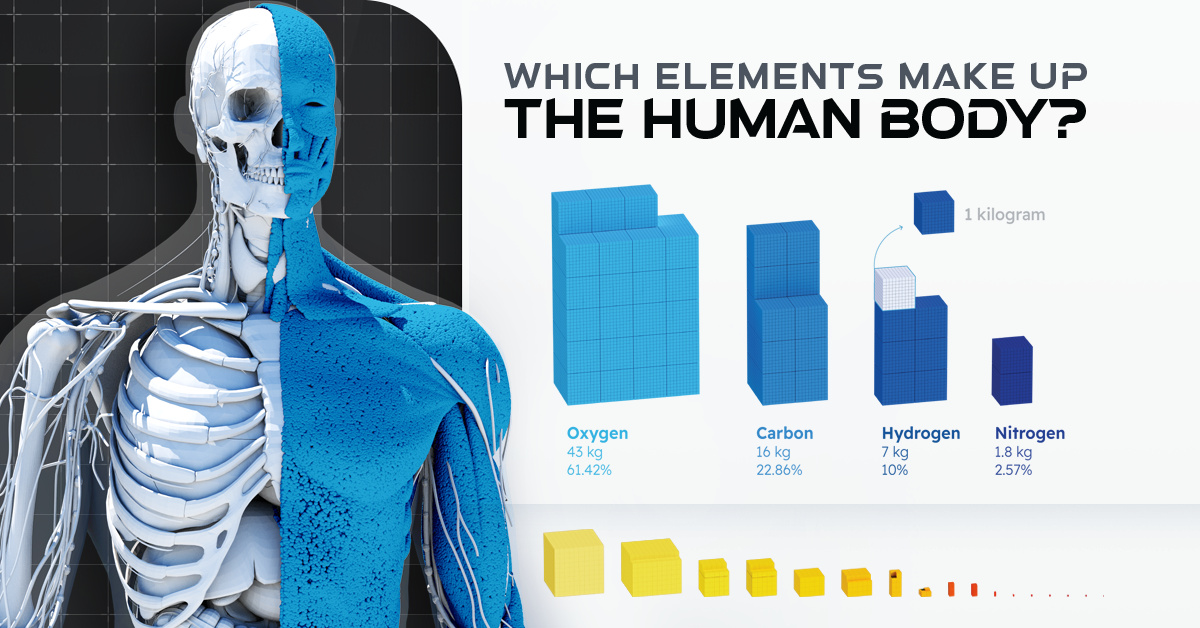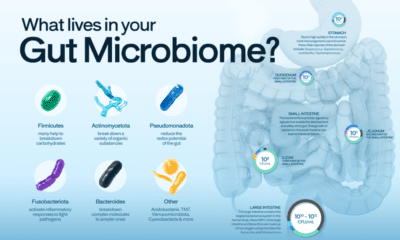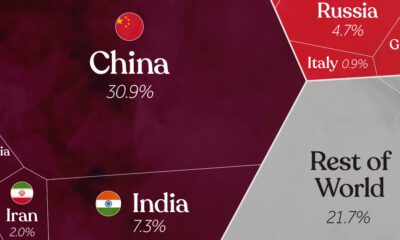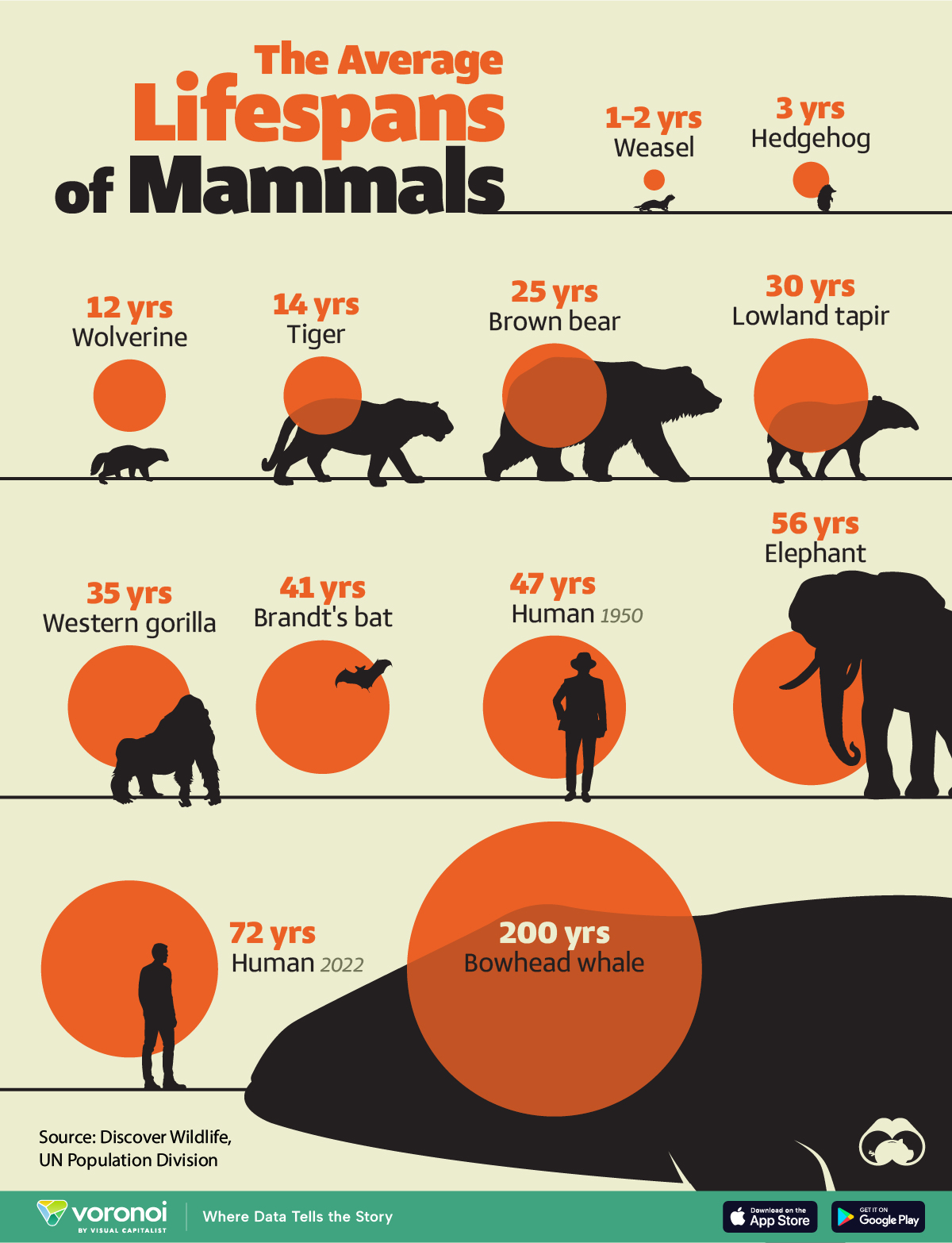Science
The Elemental Composition of the Human Body
![]() Subscribe to the Elements free mailing list for more like this
Subscribe to the Elements free mailing list for more like this
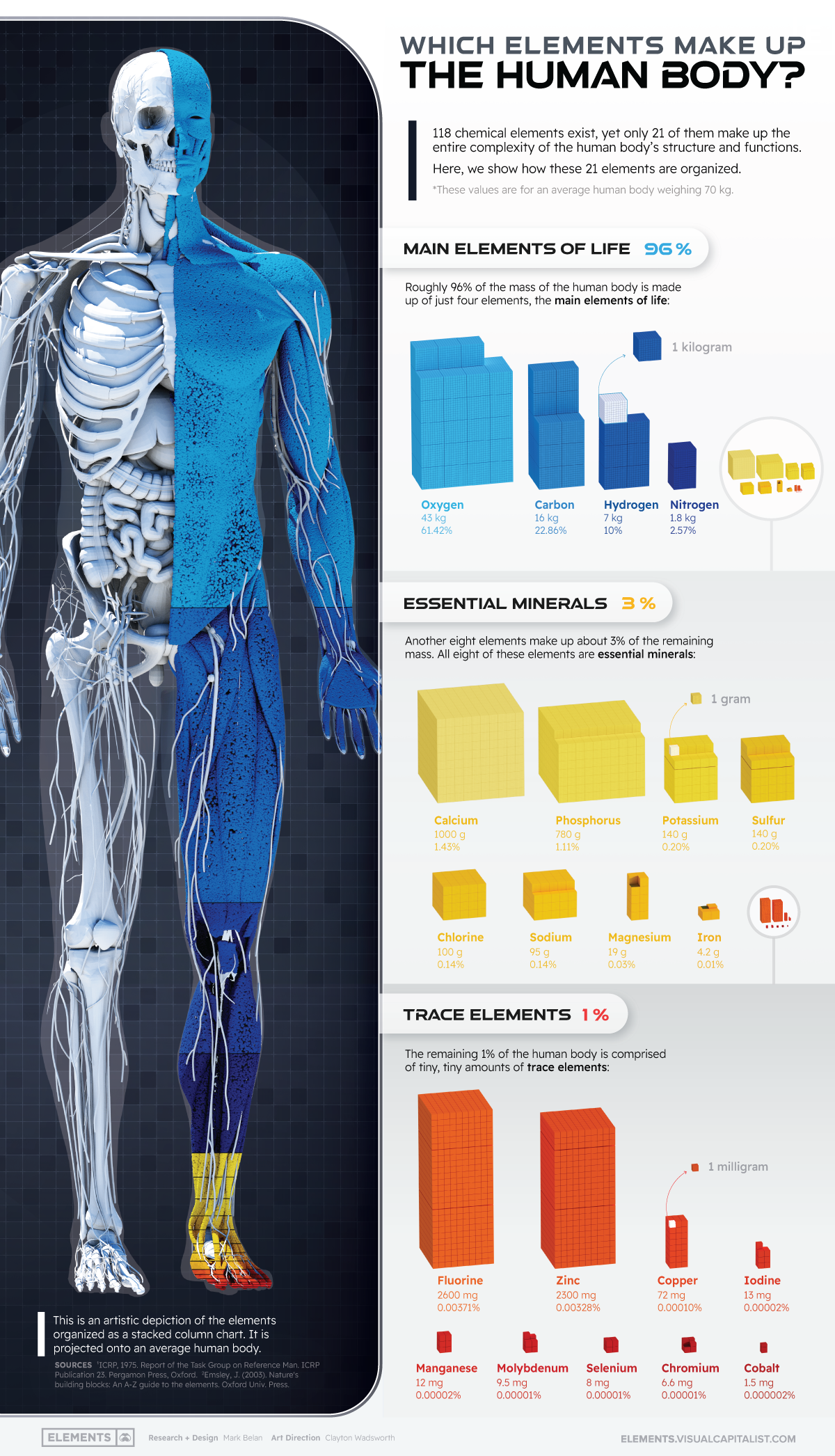
The Elemental Composition of a Human Body
This was originally posted on Elements. Sign up to the free mailing list to get beautiful visualizations on natural resource megatrends in your email every week.
The human body is a miraculous, well-oiled, and exceptionally complex machine. It requires a multitude of functioning parts to come together for a person to live a healthy life—and every biological detail in our bodies, from the mundane to the most magical, is driven by just 21 chemical elements.
Of the 118 elements on Earth, just 21 of them are found in the human body. Together, they make up the medley of divergent molecules that combine to form our DNA, cells, tissues, and organs.
Based on data presented by the International Commission on Radiological Protection (ICRP), in the above infographic, we have broken down a human body to its elemental composition and the percentages in which they exist.
These 21 elements can be categorized into three major blocks depending on the amount found in a human body, the main building block (4 elements), essential minerals (8 elements), and trace elements (9 elements).
The Elemental Four: Ingredients for Life
Four elements, namely, oxygen, carbon, hydrogen, and nitrogen, are considered the most essential elements found in our body.
Oxygen is the most abundant element in the human body, accounting for approximately 61% of a person’s mass. Given that around 60-70% of the body is water, it is no surprise that oxygen and hydrogen are two of the body’s most abundantly found chemical elements. Along with carbon and nitrogen, these elements combine for 96% of the body’s mass.
Here is a look at the composition of the four elements of life:
| Element | Weight of Body Mass (kg) | Percentage of Body Mass (%) |
|---|---|---|
| Oxygen | 43 kg | 61.4% |
| Carbon | 16 kg | 22.9% |
| Hydrogen | 7.0 kg | 10.0% |
| Nitrogen | 1.8 kg | 2.6% |
Values are for an average human body weighing 70 kg.
Let’s take a look at how each of these four chemical elements contributes to the thriving functionality of our body:
Oxygen
Oxygen plays a critical role in the body’s metabolism, respiration, and cellular oxygenation. Oxygen is also found in every significant organic molecule in the body, including proteins, carbohydrates, fats, and nucleic acids. It is a substantial component of everything from our cells and blood to our cerebral and spinal fluid.
Carbon
Carbon is the most crucial structural element and the reason we are known as carbon-based life forms. It is the basic building block required to form proteins, carbohydrates, and fats. Breaking carbon bonds in carbohydrates and proteins is our primary energy source.
Hydrogen
Hydrogen, the most abundantly found chemical element in the universe, is present in all bodily fluids, allowing the toxins and waste to be transported and eliminated. With the help of hydrogen, joints in our body remain lubricated and able to perform their functions. Hydrogen is also said to have anti-inflammatory and antioxidant properties, helping improve muscle function.
Nitrogen
An essential component of amino acids used to build peptides and proteins is nitrogen. It is also an integral component of the nucleic acids DNA and RNA, the chemical backbone of our genetic information and genealogy.
Essential and Supplemental Minerals
Essential minerals are important for your body to stay healthy. Your body uses minerals for several processes, including keeping your bones, muscles, heart, and brain working properly. Minerals also control beneficial enzyme and hormone production.
Minerals like calcium are a significant component of our bones and are required for bone growth and development, along with muscle contractions. Phosphorus contributes to bone and tooth strength and is vital to metabolizing energy.
Here is a look at the elemental composition of essential minerals:
| Element | Weight of Body Mass (g) | Percentage of Body Mass (%) |
|---|---|---|
| Calcium | 1000 g | 1.43% |
| Phosphorus | 780 g | 1.11% |
| Potassium | 140 g | 0.20% |
| Sulphur | 140 g | 0.20% |
| Chlorine | 100 g | 0.14% |
| Sodium | 95 g | 0.14% |
| Magnesium | 19 g | 0.03% |
| Iron | 4.2 g | 0.01% |
Values are for an average human body weighing 70 kg.
Other macro-minerals like magnesium, potassium, iron, and sodium are essential for cell-to-cell communications, like electric transmissions that generate nerve impulses or heart rhythms, and are necessary for maintaining thyroid and bone health.
Excessive deficiency of any of these minerals can cause various disorders in your body. Most humans receive these minerals as a part of their daily diet, including vegetables, meat, legumes, and fruits. In case of deficiencies, though, these minerals are also prescribed as supplements.
Biological Composition of Trace Elements
Trace elements or trace metals are small amounts of minerals found in living tissues. Some of them are known to be nutritionally essential, while others may be considered to be nonessential. They are usually in minimal quantities in our body and make up only 1% of our mass.
Paramount among these are trace elements such as zinc, copper, manganese, and fluorine. Zinc works as a first responder against infections and thereby improves infection resistance, while balancing the immune response.
Here is the distribution of trace elements in our body:
| Element | Weight of Body Mass (mg) | Percentage of Body Mass (%) |
|---|---|---|
| Fluorine | 2600 mg | 0.00371% |
| Zinc | 2300 mg | 0.00328% |
| Copper | 72 mg | 0.00010% |
| Iodine | 13 mg | 0.00002% |
| Manganese | 12 mg | 0.00002% |
| Molybdenum | 9.5 mg | 0.00001% |
| Selenium | 8 mg | 0.00001% |
| Chromium | 6.6 mg | 0.00001% |
| Cobalt | 1.5 mg | 0.000002% |
Values are for an average human body weighing 70 kg.
Even though only it’s found in trace quantities, copper is instrumental in forming red blood cells and keeping nerve cells healthy. It also helps form collagen, a crucial part of bones and connective tissue.
Even with constant research and studies performed to thoroughly understand these trace elements’ uses and benefits, scientists and researchers are constantly making new discoveries.
For example, recent research shows that some of these trace elements could be used to cure and fight chronic and debilitating diseases ranging from ischemia to cancer, cardiovascular disease, and hypertension.
Science
Visualizing the Average Lifespans of Mammals
While smaller animals such as weasels typically live 1-2 years, larger counterparts can thrive for decades.
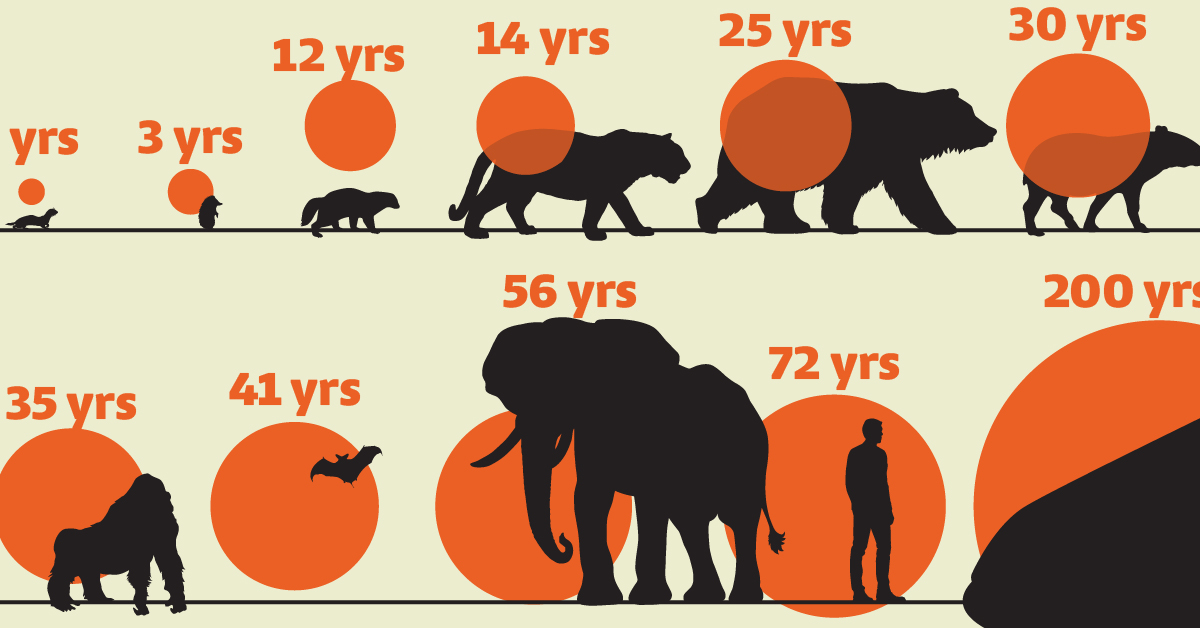
Visualizing the Average Lifespans of Mammals
This was originally posted on our Voronoi app. Download the app for free on iOS or Android and discover incredible data-driven charts from a variety of trusted sources.
Mammals, though comprising a small fraction of Earth’s creatures, hold vital ecological roles globally. They are crucial for maintaining ecosystem health through services like pollination, seed dispersal, and predator-prey dynamics.
In this visualization, we depict the average lifespans of mammals, using data from Discover Wildlife and the United Nations.
Human Lifespans on the Rise
Defined as warm-blooded creatures with hair or fur, mammals nurse their young with milk from mammary glands. While smaller animals such as weasels typically live 1-2 years, larger counterparts like elephants can thrive for decades, and bowhead whales can live for 200 years, or even longer.
| Animal | Average lifespan (years) |
|---|---|
| Weasel | 1 to 2 |
| Hedgehog | 3 |
| Wolverine | 12 |
| Tiger | 14 |
| Brown bear | 25 |
| Lowland tapir | 30 |
| Western gorilla | 35 |
| Brandt's bat | 41 |
| Humans (1950) | 47 |
| Elephant | 56 |
| Humans (2022) | 72 |
| Bowhead whale | 200 |
Notably, human lifespans have experienced a remarkable surge. According to the UN Population Division, the global average life expectancy has surged from 47 years in 1950 to 72 years in 2022, marking a 25-year increase. This is attributed to advancements in nutrition, medication, and essential resources.
However, as human longevity flourishes, it can have an adverse effect on wildlife mammal populations. To put this into numbers, over the past 100,000 years, the surge in human population has precipitated an 85% reduction in wild mammal biomass.
Today, livestock dominates 62% of the world’s mammal biomass, with humans accounting for 34%, while wild mammals comprise only 4%.
Despite a decline in mammal diversity, the total biomass of terrestrial mammals has significantly increased, expanding approximately ninefold over the past 10,000 years.
Curious to learn more about mammals? Check out this graphic that shows the biomass of all the world’s mammals.
-

 Travel1 week ago
Travel1 week agoAirline Incidents: How Do Boeing and Airbus Compare?
-

 Markets2 weeks ago
Markets2 weeks agoVisualizing America’s Shortage of Affordable Homes
-

 Green2 weeks ago
Green2 weeks agoRanked: Top Countries by Total Forest Loss Since 2001
-

 Money2 weeks ago
Money2 weeks agoWhere Does One U.S. Tax Dollar Go?
-

 Misc2 weeks ago
Misc2 weeks agoAlmost Every EV Stock is Down After Q1 2024
-

 AI2 weeks ago
AI2 weeks agoThe Stock Performance of U.S. Chipmakers So Far in 2024
-

 Markets2 weeks ago
Markets2 weeks agoCharted: Big Four Market Share by S&P 500 Audits
-

 Real Estate2 weeks ago
Real Estate2 weeks agoRanked: The Most Valuable Housing Markets in America




